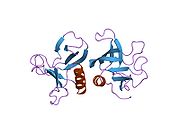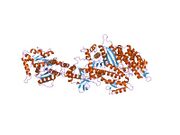Biology:DNM1
 Generic protein structure example |
Dynamin-1 is a protein that in humans is encoded by the DNM1 gene.[1][2]
Function
This gene encodes a member of the dynamin subfamily of GTP-binding proteins. The encoded protein possesses unique mechanochemical properties used to tubulate and sever membranes, and is involved in clathrin-mediated endocytosis and other vesicular trafficking processes. Actin and other cytoskeletal proteins act as binding partners for the encoded protein, which can also self-assemble leading to stimulation of GTPase activity. More than sixty highly conserved copies of the 3' region of this gene are found elsewhere in the genome, particularly on chromosomes Y and 15. Alternatively spliced transcript variants encoding different isoforms have been described.[3]
Role in disease
De novo mutations in DNM1 have been associated with a severe form of childhood epilepsy called developmental and epileptic encephalopathy. Most pathogenic variants are missense variants, and have been shown to impair synaptic vesicle endocytosis in a dominant negative manner.[4]
Interactions
DNM1 has been shown to interact with:
References
- ↑ "Molecular cloning of the microtubule-associated mechanochemical enzyme dynamin reveals homology with a new family of GTP-binding proteins". Nature 347 (6290): 256–61. October 1990. doi:10.1038/347256a0. PMID 2144893.
- ↑ "Assignment of the dynamin-1 gene (DNM1) to human chromosome 9q34 by fluorescence in situ hybridization and somatic cell hybrid analysis". Genomics 41 (2): 286–9. July 1997. doi:10.1006/geno.1996.4596. PMID 9143509.
- ↑ "Entrez Gene: DNM1 dynamin 1". https://www.ncbi.nlm.nih.gov/sites/entrez?Db=gene&Cmd=ShowDetailView&TermToSearch=1759.
- ↑ "Epileptic encephalopathy-causing mutations in DNM1 impair synaptic vesicle endocytosis". Neurology. Genetics 1 (1): e4. June 2015. doi:10.1212/01.NXG.0000464295.65736.da. PMID 27066543.
- ↑ 5.0 5.1 "Synaptojanin forms two separate complexes in the nerve terminal. Interactions with endophilin and amphiphysin". J. Biol. Chem. 272 (43): 27239–45. October 1997. doi:10.1074/jbc.272.43.27239. PMID 9341169.
- ↑ "Amphiphysin heterodimers: potential role in clathrin-mediated endocytosis". Mol. Biol. Cell 8 (10): 2003–15. October 1997. doi:10.1091/mbc.8.10.2003. PMID 9348539.
- ↑ "Clathrin interacts specifically with amphiphysin and is displaced by dynamin". FEBS Lett. 413 (2): 319–22. August 1997. doi:10.1016/s0014-5793(97)00928-9. PMID 9280305.
- ↑ "Dynamin is a minibrain kinase/dual specificity Yak1-related kinase 1A substrate". J. Biol. Chem. 277 (20): 17597–604. May 2002. doi:10.1074/jbc.M111101200. PMID 11877424.
- ↑ "The SH3 domain of amphiphysin binds the proline-rich domain of dynamin at a single site that defines a new SH3 binding consensus sequence". J. Biol. Chem. 272 (20): 13419–25. May 1997. doi:10.1074/jbc.272.20.13419. PMID 9148966.
- ↑ 10.0 10.1 "A novel dynamin-associating molecule, formin-binding protein 17, induces tubular membrane invaginations and participates in endocytosis". J. Biol. Chem. 279 (38): 40091–9. September 2004. doi:10.1074/jbc.M404899200. PMID 15252009.
- ↑ "Association of Ash/Grb-2 with dynamin through the Src homology 3 domain". J. Biol. Chem. 269 (8): 5489–92. February 1994. doi:10.1016/S0021-9258(17)37484-7. PMID 8119878.
- ↑ "Multiple Grb2-protein complexes in human cancer cells". Int. J. Cancer 70 (2): 208–13. January 1997. doi:10.1002/(sici)1097-0215(19970117)70:2<208::aid-ijc12>3.0.co;2-e. PMID 9009162.
- ↑ "Characterization of interactions of Nck with Sos and dynamin". Cell. Signal. 11 (1): 25–9. January 1999. doi:10.1016/s0898-6568(98)00027-8. PMID 10206341.
- ↑ "All three PACSIN isoforms bind to endocytic proteins and inhibit endocytosis". J. Cell Sci. 113 (24): 4511–21. December 2000. doi:10.1242/jcs.113.24.4511. PMID 11082044.
- ↑ "Characterization of Endophilin B1b, a brain-specific membrane-associated lysophosphatidic acid acyl transferase with properties distinct from endophilin A1". J. Biol. Chem. 278 (6): 4160–7. February 2003. doi:10.1074/jbc.M208568200. PMID 12456676.
Further reading
- Sever S (2003). "Dynamin and endocytosis.". Curr. Opin. Cell Biol. 14 (4): 463–7. doi:10.1016/S0955-0674(02)00347-2. PMID 12383797.
- "Dynamin: characteristics, mechanism of action and function.". Cell. Mol. Biol. Lett. 7 (4): 1073–80. 2003. PMID 12511974.
- "Dynamin at the actin-membrane interface.". Curr. Opin. Cell Biol. 15 (1): 31–9. 2003. doi:10.1016/S0955-0674(02)00010-8. PMID 12517701.
- "Crystal structure of the pleckstrin homology domain from dynamin.". Nat. Struct. Biol. 1 (11): 782–8. 1995. doi:10.1038/nsb1194-782. PMID 7634088.
- "Three-dimensional solution structure of the pleckstrin homology domain from dynamin.". Curr. Biol. 4 (10): 884–91. 1995. doi:10.1016/S0960-9822(00)00197-4. PMID 7850421.
- "Crystal structure at 2.2 A resolution of the pleckstrin homology domain from human dynamin.". Cell 79 (2): 199–209. 1994. doi:10.1016/0092-8674(94)90190-2. PMID 7954789.
- "Mutations in human dynamin block an intermediate stage in coated vesicle formation.". J. Cell Biol. 122 (3): 553–63. 1993. doi:10.1083/jcb.122.3.553. PMID 8101525.
- "Association of Ash/Grb-2 with dynamin through the Src homology 3 domain.". J. Biol. Chem. 269 (8): 5489–92. 1994. doi:10.1016/S0021-9258(17)37484-7. PMID 8119878.
- "Oligo-capping: a simple method to replace the cap structure of eukaryotic mRNAs with oligoribonucleotides.". Gene 138 (1–2): 171–4. 1994. doi:10.1016/0378-1119(94)90802-8. PMID 8125298.
- "Differential expression and regulation of multiple dynamins.". J. Biol. Chem. 269 (6): 4547–54. 1994. doi:10.1016/S0021-9258(17)41812-6. PMID 8308025.
- "The SH3 domain of amphiphysin binds the proline-rich domain of dynamin at a single site that defines a new SH3 binding consensus sequence.". J. Biol. Chem. 272 (20): 13419–25. 1997. doi:10.1074/jbc.272.20.13419. PMID 9148966.
- "Identification and characterization of a nerve terminal-enriched amphiphysin isoform.". J. Biol. Chem. 272 (26): 16700–6. 1997. doi:10.1074/jbc.272.26.16700. PMID 9195986.
- "The SH3p4/Sh3p8/SH3p13 protein family: binding partners for synaptojanin and dynamin via a Grb2-like Src homology 3 domain.". Proc. Natl. Acad. Sci. U.S.A. 94 (16): 8569–74. 1997. doi:10.1073/pnas.94.16.8569. PMID 9238017.
- "Clathrin interacts specifically with amphiphysin and is displaced by dynamin.". FEBS Lett. 413 (2): 319–22. 1997. doi:10.1016/S0014-5793(97)00928-9. PMID 9280305.
- "Amphiphysin heterodimers: potential role in clathrin-mediated endocytosis.". Mol. Biol. Cell 8 (10): 2003–15. 1997. doi:10.1091/mbc.8.10.2003. PMID 9348539.
- "Construction and characterization of a full length-enriched and a 5'-end-enriched cDNA library.". Gene 200 (1–2): 149–56. 1997. doi:10.1016/S0378-1119(97)00411-3. PMID 9373149.
- "In mouse brain profilin I and profilin II associate with regulators of the endocytic pathway and actin assembly.". EMBO J. 17 (4): 967–76. 1998. doi:10.1093/emboj/17.4.967. PMID 9463375.
- "Role of phosphorylation in regulation of the assembly of endocytic coat complexes.". Science 281 (5378): 821–4. 1998. doi:10.1126/science.281.5378.821. PMID 9694653.




